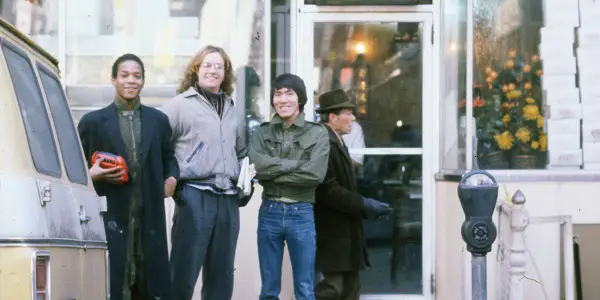Jean-Michel Basquiat was only 27 when he died of a heroin overdose in 1988, but his art, infused with biting social commentary and punk attitude, continues to be almost ubiquitous in pop culture. (I mean, you can even buy shirts emblazoned with Basquiat art at Uniqlo and Urban Outfitters.) His vibrant work perfectly encapsulates the time and place in which he came of age: 1970s New York, a city ripe with rebellion, creativity, and opportunity.
In the new documentary Boom for Real: The Late Teenage Years of Jean-Michel Basquiat, filmmaker and Basquiat contemporary Sara Driver brings that long-gone version of New York back to life and explores the role it played in the emergence of Basquiat as an artistic icon. It’s a very narrow focus for a documentary, but in Driver’s capable hands, it works, bringing viewers deep into the heart of the thriving downtown art scene at a time when New York still felt like a place where anyone could become a star.
Portrait of the Artist as a Young Man
In 1978, Basquiat was 18 and jumping from one friend’s couch to another in the East Village in lieu of having a permanent residence of his own. He first burst onto the scene in New York as part of the graffiti duo SAMO, tagging the streets of the city with poetic phrases and snarky comments. Eventually, he moved off of the walls of the city and into its galleries, making the transition from street art to painting.

Along the way, he encountered a colorful cast of characters straight out of the pages of Patti Smith’s modern classic Just Kids. Many of these New York artistic luminaries – including the other member of SAMO, Al Diaz, Sex and the City costume designer Patricia Field, and Driver’s longtime partner, the filmmaker Jim Jarmusch – appear in Boom for Real to share their recollections of Basquiat and how he fit into their universe. And of course, there is no shortage of footage of young Basquiat himself, smiling enigmatically as he tags walls and wanders through the streets.
In addition to her close friendships with the people involved in the downtown New York art scene at that time and her own memories of Basquiat, Driver utilizes a treasure trove of art and writing belonging to Basquiat that was saved by Alexis Adler. A leading embryologist and close friend of Basquiat, Adler appears in Boom for Real and describes how she gave Basquiat a key to her apartment in 1979 so that he could settle down in a safe place and focus on his art. Her own photographs of Basquiat working in that apartment also appear in the film and give the viewer a keen look into the artistic process of a legend.
People love to romanticize New York during this time – before AIDS, before Reagan, before money began to speak louder than creativity. The New York of the 1970s, of Basquiat and Patti Smith, Mapplethorpe and Grandmaster Flash, was an ideal place for an artist to develop – it was cheap to live (imagine that!) and presented numerous opportunities to encounter artists and influences across all mediums in clubs and galleries. Hip-hop was emerging and punk rock was raging.
Of course, it was also rife with crime, violence, and drugs. Driver takes us inside the legendary clubs of the era and interviews subjects who all speaking glowingly of how they spent their reckless youth couch-surfing and pill-popping, but she shows us that dark underbelly of old New York too. After all, it too was an influence on the work of Basquiat; to leave it out for the sake of exalting the past would do a disservice to both the city and the man.
Conclusion: Boom for Real
Boom for Real benefits from Driver’s intimate familiarity with its subject: both Basquiat himself and the downtown New York in which he thrived. It could have easily felt like a trifle of a documentary, just another film too focused on glorifying the New York that vanished forever when Giuliani took office and set about “cleaning up” the rough and tumble streets.
Instead, it’s an eye-opening look at how one unique artist was molded and inspired by the time and place in which he lived.
What do you think? Would you prefer a Basquiat documentary covering the span of his all-too-short life, or does Boom for Real’s hyper-focused premise sound appealing to you? Share your thoughts in the comments below.
Boom for Real: The Late Teenage Years of Jean-Michel Basquiat was released in the U.S. on May 11, 2018 and in the UK on June 22, 2018. You can find more international release dates here.
Does content like this matter to you?
Become a Member and support film journalism. Unlock access to all of Film Inquiry`s great articles. Join a community of like-minded readers who are passionate about cinema - get access to our private members Network, give back to independent filmmakers, and more.